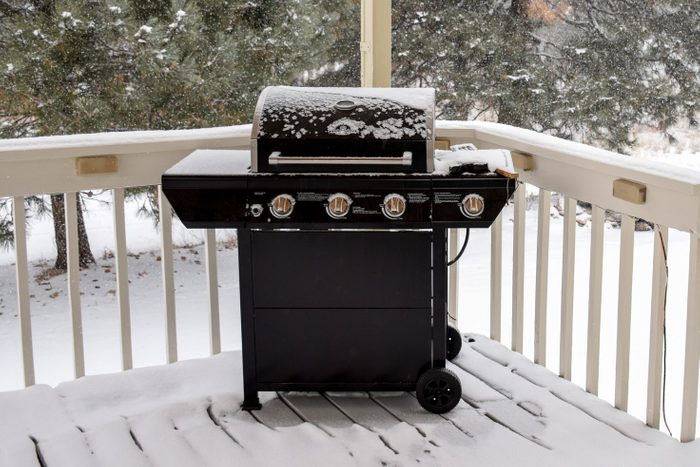Is Your Gas Grill Ready for Winter?
Updated: Nov. 16, 2022

If you want your grill to work in the spring, it's important to get it ready for winter.
Your gas grill has been a trusty companion these last few months, the centerpiece of your outdoor kitchen and a way to relax outside. But now that winter’s here, if you’re not planning any more outdoor cooking, it’s important to winterize your gas grill before the snow starts flying. Think of it like winterizing your lawn mower, another step to preserve your stuff.
There’s a little more to winterizing your grill than just throwing a cover on it and stowing in the shed for the next four months. If you don’t take the proper steps, you might find yourself buying a new grill. Fortunately, it’s not difficult. Just follow the steps below and your grill will be ready when you need it in the spring.
On This Page
Shut Off the Gas
Shut off the gas at the LP tank, unfasten the burner and slip the gas tubes off the gas lines. (Check your owner’s manual for how to do this on your model.) Then lift out the unit as a whole.
Clean Your Grill
The first step is deep cleaning your gas grill. It’s essential to get ALL the gunk off it. Germs can live on the dried bits of food, and that charred stuff on your grates can be carcinogenic. Cleaning your grill also helps prevent corrosion.
After scraping it clean and degreasing it, inspect and clean the igniters. If you grill has a catch pan, grease tray, lower cabinet, etc., don’t forget to clean those as well.
For the last step, polish the outside of your grill to give it an extra layer of protection.
Coat the Burners with Cooking Oil
Coat the burners and other metal parts with cooking oil to repel moisture that can build up over the winter. Then wrap the burner unit in a plastic bag to keep spiders and insects from nesting in the gas tubes. This is a common problem that can make for balky starts, uneven flames or even a one-alarm fire the next time you light your grill.
How to Store the Propane Tank
If you’re storing your gas grill outside during the winter, keep the propane tank connected (but shut off) and put a protective cover over the entire grill. (More on this below.)
If you’re storing the grill indoors, don’t bring the tank inside, not even into the garage or a storage shed. A small gas leak can cause a huge explosion if you store the tank in an enclosed space. Instead, disconnect the tank and put it outside in an upright position, away from dryer and furnace vents and children’s play areas.
Take Care of Your Grill’s Small Parts
Tape a plastic bag over the gas line opening to prevent insects from nesting. If your grill has an electric starter, remove the battery for the winter. If you don’t, it can corrode the contacts.
If your grill came with a rotisserie motor, it’s not a bad idea to take that out before storing to keep moisture out of it.
Cover Your Grill
Buy a cover for your grill and put it on before you put it away for the winter. If you’re leaving the grill outside, this step is essential. No matter how well you’ve taken care of your grill, the elements will exact a heavy toll during the cold weather months if you don’t cover it, shortening its life.
If possible, store your covered grill in a garage or other enclosed area. Keeping it out of the snow, ice and cold will protect it. If your garage isn’t an option, consider another covered area for extra protection — say, the overhang on your porch.




















